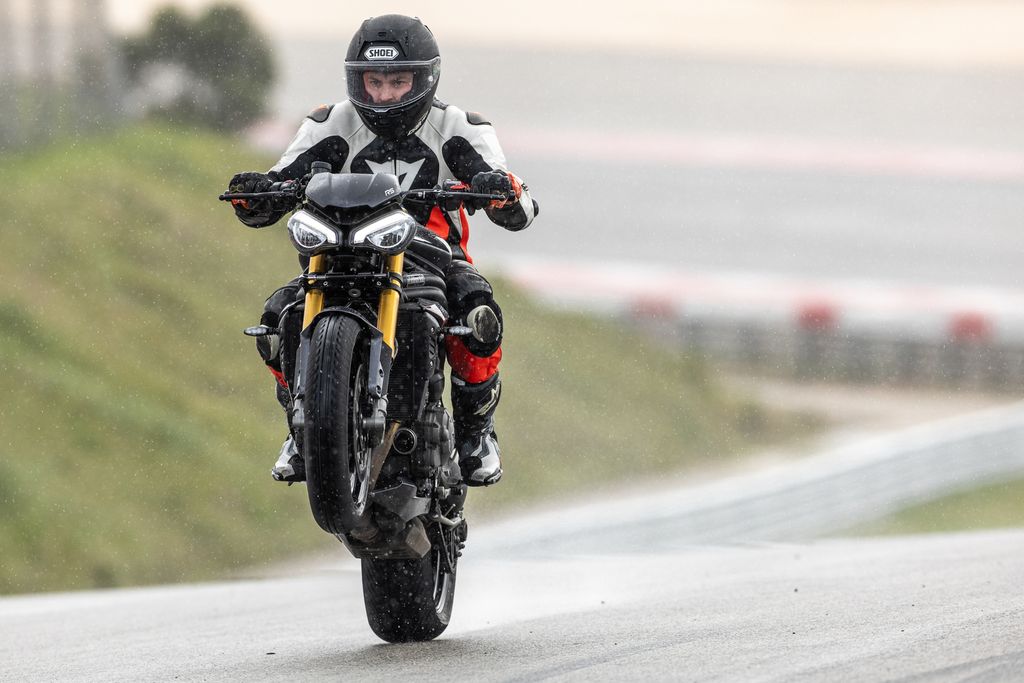One bike—that’s all many of us get. I agonize over the idea of a single-bike garage more than I’d like to, and how to get around the problem. “Well, what if I split my money between two older bikes—one for the twisties, one for touring…” before I hit a factory refresh on my search parameters and start all over again.
Suddenly, new tall-rounders, hyper nakeds, and sport tourers start looking pretty attractive—I’m back to the idea of the perfect single-bike garage. It’s draining because you know one bike can never really do it all, but holy hell does Triumph’s 2025 Speed Triple 1200 RS come as close as anything I’ve ridden.
At least, for my needs.
The latest Speed Triple is as aggressive and competent on track as its hyper naked status warrants, but plusher than most tall-rounders on a long, bumpy road, and will carve a canyon like a Christmas turkey. There must be a trick to making a single bike that essentially gives you the versatility of three—there is, and we’ll get to it. First, I wanted to soundboard my two-wheeled experience, and make sure I wasn’t just all loved up after riding the Portimau Circuit.

When I spoke to RideApart’s Executive Editor, Jonathon Klein, about my thoughts, he immediately drew a parallel after I laid out the case for the Triumph. “You’re describing a McLaren 750S,” he stated matter-of-factly, “Which is probably the perfect supercar.”
“The thing that struck me the most about the McLarens I’ve driven,” Klein tells me, “Was how it had this Jekyll and Hyde character. Tootling around town, you might forget you were in this low-slung, nightmarishly powerful supercar, as it handled the rutted, pot-holed, broken city streets with SUV-like demeanor—plush, smooth, and completely obfuscating the road's imperfections. And then, with a push of a button, and the bravery it takes to smash the gas pedal all the way to the floor, you'd remember McLaren makes hypercars and Formula 1 racers—and that they win championships in the latter."
Gearheads are driven by the feelings and emotions created by hardware and software beneath them. But can a $19,995 motorcycle and $324,195 supercar align as similarly as Klein described?
It turns out, yes, especially when you dig into the suspension setups.
One of Four
The Speed Triple 1200 RS is one of only four motorcycles with the Ohlins SmartEC3 suspension system—the others being the Panigale V4S, Streetfighter V4S, and CBR1000RR-R Fireblade. So, essentially, the rest of the competition are the premium superbikes and arguably the most aggressive hyper naked on the market.
It’s worth mentioning that the Speed Triple costs around $10,000 less than the nearest competitor mentioned above. Moreover, none of the other models have the ergonomic and engine characteristics that enable the Speed Triple to go from (almost) sport tourer to hyper naked.



I’ve ridden bikes that change character when you select a different riding mode, but opting for a different riding mode on the Speed Triple is almost like changing motorcycles entirely.
Comfort Mode on this bike isn’t just comfortable for a hyper naked, it’s comfortable full stop, and this area was under the microscope due to the weather conditions.
On the wet, cold, bumpy roads surrounding Portimao, Portugal, when my supposedly waterproof jacket had soaked through, the last thing I wanted was a bone-shaking, razor-sharp ride—on most hyper nakeds, that’s what I’d have gotten.
I watched the first bumps approach, braced for impact, but instead of a thud, I felt a plush push against the undulation—I thought maybe I’d overestimated the bump. But, I hadn't; I had underestimated the capabilities of the Ohlins SmartEC3 suspension system. Once we reached our first photo stop, I selected Sport Mode to hit a nice shot, but again, I underestimated how sharp two taps on the switchgear could make the Speed Triple’s handling. As soon as I thought about tipping into the corner, the bike was at lean.
I’ve never experienced such a change in the composition of a motorcycle with a couple of inputs on a screen. I needed to tone it back to Normal Mode to suit the cold, relatively bumpy roads.



The Speed Triple’s ergonomics, seat, and suspension system had me seriously considering fabricating panniers and fitting a tall(ish) screen to make the most perfect sports tourer (for me) that’s ever existed.
Older semi-active suspension setups have been criticized for not reacting as quickly or as dynamically as well-set-up conventional suspension; the Ohlins SmartEC3 OBTi (Objective-Based Tuning Interface) setup changes that conversation. This system uses spool-valve technology to react faster and more precisely to road/track conditions, and has a wider dynamic range of operation.
The suspension will keep everything smooth should you hit a new pothole or let you dial in the bike’s composure as you round turn one on a MotoGP track. To get a better understanding of the reason automakers are using semi-or pro-active suspension, which can turn track machines into cruisers, I spoke to the man who was largely responsible for engineering the pro-active suspension in the McLaren 750S, McLaren’s Principal Project Engineer—Chassis Systems, Stephen Paine.
When speaking about the reason behind putting active-suspension in one of the most-loved supercars on the market, Paine stated, “And the reason why we use a semi-active system, or a damping system with authority, is really the better way of putting it, is because we want to make cars that have bandwidth… That's kind of the thing that we do… We want to make you a car that can go on track and do things on track that a car that rides as well on a B road should not be able to do.”
Therein lies the story of the Speed Triple 1200 RS—bandwidth.

You can independently adjust essentially every aspect of the suspension, like brake assist, weight transfer, initial acceleration assist, and cornering grip, to name a few, and all with the touch of your left thumb. The only thing this system can’t change is the preload, but it does recommend a preload setting based on how much you weigh.
Such smart suspension needs an equally capable electronics suite to make everything feel natural and work in unison.
Teasing the Track
Even if the asphalt was drier than my mouth on a Sunday morning, you’re never going to fully exploit the Speed Triple on public roads. Fortunately, in addition to the day’s ride around the Algarve, I had a full day of testing at the MotoGP and Formula 1 Portimao race circuit penciled in, too, for day two on the bike. Unfortunately, it was raining.
But, on track, I was reminded about one of the 1160cc three-cylinder motor’s quintessential attributes: This is one of the nicest sounding motorcycles with a stock pipe on the market, especially at full tilt on the Portimao main straight. But this dog is so much more than the sound of its bark.



To some, the sound of such linear power might sound boring, but when you’re dealing with 94.4 lb-ft of torque at 8,750 rpm and 180.5 hp at 10,750 rpm, it feels like you have a bomb in your right hand that’s always ready to explode. The engine never stutters; instead, it relentlessly pulls you forward, regardless of what gear you’re in, and finishes its song with an almost inline-four bite at the top of the rev range.
When you crack the throttle to exit a turn, and know exactly how the power delivery will open up the corner and that the bike will follow the line you’ve drawn in your mind’s eye, that linear power delivery finds a place in your heart. Don’t mistake predictable power for boring because that’s the last thing this engine delivers.
You have more torque at your disposal than a Streetfighter V4 on a bike that weighs even less, and once you get on the gas with any real intention, the new slightly wider and taller handlebars start to feel lighter and lighter, until they’re weightless. Without trying, the front wheel will take flight on the throttle given half a chance in the first few gears.
The engine’s mass is more centralized now, thanks to a new free-flowing, compact exhaust system. Add to this a new, narrower seat connected to a tank that almost hooks your legs, and the Speed Triple feels much more like a bike you become a part of while cornering, rather than a bike you sit atop of, which is how I felt on the Speed Triple 1050 RS.



Tipping my way up the Quick Assist quickshifter, I hit around 260 kph (161 mph) before braking into turn one. Once I let a sliver of light between my chin and the tank, the air peeled my body back like a banana skin. To say there’s no wind protection almost seems like an understatement—if you can hold on, you perform as an excellent air brake.
Pulling for the MCS lever, which works with the MCS Radial Master Cylinder to bite down on the front 320mm Brembo discs with Stylema calipers almost instantly calmed my frenzied rush with strong, progressive power—the first day, on the road, I was caught off-guard by what a light squeeze would to and needed to recalibrate, but this isn’t something to complain about.
I was incredibly thankful for the feel in such wet conditions, giving me the confidence to trail brake. I couldn't help but wonder how much deeper I would brake in dry conditions. And this is the biggest caveat to my time on track because I can’t say for sure if the suspension is stiff enough for serious track riders on a dry track. But, I’ll say with confidence, it’s an excellent-handling road bike at speed, and should be good for light-to-moderate trackday enthusiasts.

I didn’t find that the bike turned in particularly quickly—there are certainly sharper hyper nakeds on the market, although the new handlebars provide plenty of leverage. On the other hand, I thought it was exceptionally stable at high speeds, holding lean angles in a way that gave me superb confidence, and on a windy, undulating, and wet Portimao track, I couldn’t have been more grateful to the engineers behind the package.
You Could Have More, But You Don’t Need It
There’s the uber-extreme riding position that some hyper nakeds have and 200 hp-plus figures that come with them, which make you hesitate and stare blankly into space for a second. The Speed Triple doesn’t have this—OK, the power isn’t far off that mark—and it’s all the better for it. But it’s not flailing in comparison to its sportier competitors, and it has something they don’t: an almost flat torque curve.
Don’t get it twisted, the Speed Triple and its Ohlins SmartEC3 will dance around the track with accuracy, and even more so when you configure the suspension to suit your riding style, which is addictive in its own right, although the interface can be frustratingly slow to respond at times. And it’s not devoid of feeling due to the semi-active system—the opposite, in fact.


Grip levels didn’t just change throughout the track day; they changed turn by turn, and I could feel the changing conditions through the beautifully responsive Ohlins system. I’d have to guess and say the Speed Triple has nine-tenths of the performance of most track-oriented hyper nakeds, but if you changed its ergonomics to compete more on track, it’d take away from how dynamic it is in terms of comfort.
This was the original hooligan machine when it launched in 1994, and if anything, it’s less of a law-abiding citizen than ever. Thanks to some extremely clever engineering, the Speed Triple has the best front wheel lift control I’ve ever used, and probably on any bike to date—this bike is the gateway drug to becoming a wheelie addict.

A Relative Bargain
Before anyone accuses me of being a moneybags, know that I can’t afford any of the vehicles I’m about to mention. When I’m talking about bargains, I mean relative bargains. And the McLaren 750S, which starts at $349,000, has to be one of the best relative bargains in the supercar world.
Before you protest too much, consider that the 750S’s closest rivals are the Lamborghini Revuelto, which starts at $608,358, and the Ferrari SF90, which starts at around $593,950.
In the same vein, if you want to compare the new Speed Triple RS to anything, it has to be HYPER nakeds that feature the SmartEC3 system because it has moved the game forward that much. And there is only one: the Ducati Streetfighter V4S. The Streetfighter V4S starts at $29,295, while the Speed Triple 1200 RS has an MSRP of $19,995.



I haven’t ridden the Streetfighter V4S, but I’m sure there’s an argument for it, whether you want to be a couple of seconds faster on track, prefer how it looks, or love the feeling of a V4 engine. But the Speed Triple is two-thirds of the price, unbelievably comfortable for a hyper naked, and has bags of performance. It feels weird to call the Speed Triple a smart money buy, but is there any other way to see it?
If you’ve got the hooligan in you and want to express that attitude further from home than ever before, this is the bike. It makes race tracks feel closer even when many crappy miles of asphalt stand between you and said circuit, and when you get there, it’ll still rip.
This is certainly in contention for my sub $20k one-bike garage list. If Triumph wants to give me a long-term loaner, I’ll show everyone just how capable this model is.







